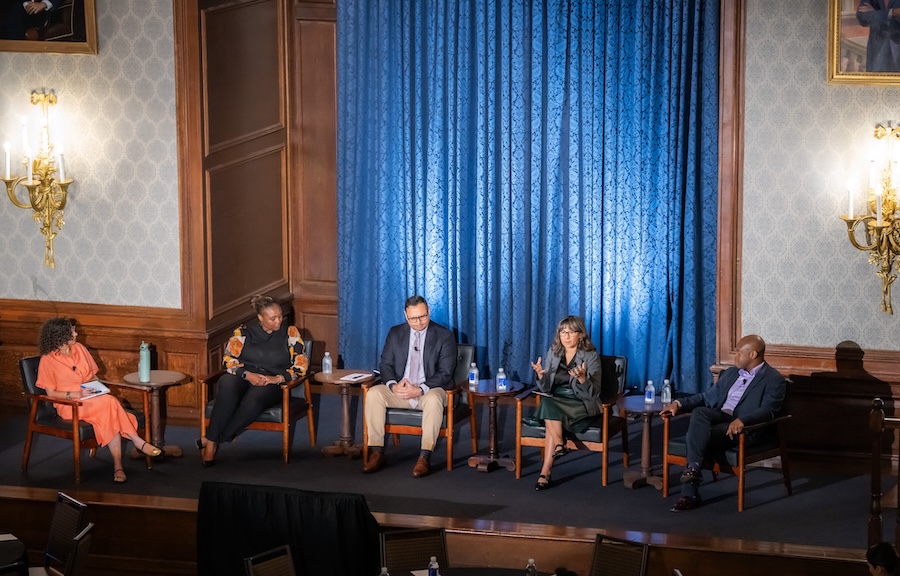Embedding Company Values Into the Daily Work Experience


“My life mantra is lift as I climb,” Geneva Brown said during an executive panel discussion at From Day One’s Philadelphia conference.
Brown, the chief sustainability and inclusion officer at the Cigna Group, says that culture begins with small, deliberate steps, such as setting aside a calendar block for employee calls, leaving a reminder note to follow up, or maintaining an unwavering commitment to creating safe spaces.
Brown and a panel of other leaders shared thoughts on the topic “Culture That’s Real: Translating Company Values Into Everyday Reality,” to discuss the everyday mechanics of company culture, including how organizations listen to employees, turn feedback into action, and adopt new technologies without losing sight of the human skills that matter.
“You may not have solutions to every issue, but that ability to pause and listen is critically important,” Brown said. Her team reserves an hour each day for outreach and keeps a running checklist to ensure team members feel heard.
Martel Neville, VP of HR at Comcast, echoed that sentiment. “Let's just remember the golden rule, which is, treat others as you want to be treated,” he added. Neville outlined a mix of quarterly and annual surveys used at Comcast, as well as mandatory team huddles to review feedback and track escalations. These team huddles are how leaders figure out how to “listen, learn, and act,” he said.
Turning Feedback Into Action
The panelists went on to share systems that address employee concerns once their feedback has been received, including tools that route issues, assign them, and display status updates. Tracking escalations and their solutions creates transparent, accountable follow-through, says Neville.
It’s important to push beyond surveys toward systems that close gaps. Neville described tracking escalations “so people could actually, literally click it to watch it go, to progress inside the organization.” That transparency converts sentiment into visible, accountable change.
Angie Parsons, the director of product marketing at Beekeeper, emphasized the connection between communication gaps and cultural gaps: “If you have leadership mandating certain things, but the frontline workers aren't getting the same communication streams, then you're already creating a lot of disconnect.”
Her solution is an employee experience hub that centralizes messages and makes organizations more inclusive for shift and frontline workers.
Recognition As Culture
The way people are seen, heard, and recognized also informs workplace culture. To Omar Pradhan, recognition is “the opportunity to have a thoughtful, deliberate pause.”

Pradhan, an employee engagement and HR technology strategist at Workhuman, shared how their platform utilizes impact-focused language, making recognition a record of behavior and a source of data for informed talent decisions.
“Recognition can also be a revealer of the skills that people are demonstrating over time and readiness for promotion,” he said. That combination, utilizing recognition to validate employees personally and as a system of record analytics, enables companies to celebrate individuals while revealing patterns that managers can act upon.
Embrace AI, But Keep Things Human
In exploring new ways to strengthen communication and accountability, Brown described how she’s using AI to draft prompts for difficult conversations and to design exercises that encourage proactive ownership of follow-through and results.
Additionally, organizations can use AI to “synthesize all the information” gathered from surveys to highlight trends managers should address, said Parsons.
As AI transforms the workplace, Neville noted that companies are beginning to prioritize human skills over technical ones—empathy, clarity, and leadership behaviors. “Clarity is kindness,” he said, citing researcher Brené Brown, whose work explores courage, vulnerability, and empathy.
AI’s role is to scale insights and free up time; people still must do the human work of translating those insights into productive outcomes, panelists agreed.
Building Community and Belonging
Volunteer days and community engagement remain powerful ways to strengthen workplace culture. Neville described “Team Up” volunteer opportunities, which give employees a sense of purpose and belonging while also fostering stronger connections across teams.
Parsons offered an example of how community engagement can extend beyond the workplace. During Hurricane Helene, customers used Beekeeper’s platform to self-organize cleanup crews and raise funds. “Bringing that community element to work,” she said, “was really, really important,” highlighting how purpose and collaboration strengthen both company culture and broader communities.
To end the session, panelists offered one question every HR leader should ask. Brown’s was simple and probing: “Did I create space for someone?” Pradhan asked, “How do we bring the culture off the walls?” Parsons focused on managers, “How am I leveraging my middle managers to the best of their ability?” Neville boiled it down to outcomes: “How am I helping the folks that are in my arena to thrive?”
Ade Akin covers workplace wellness, HR trends, and digital health solutions.
(Photos by Josh Larson for From Day One)
The From Day One Newsletter is a monthly roundup of articles, features, and editorials on innovative ways for companies to forge stronger relationships with their employees, customers, and communities.